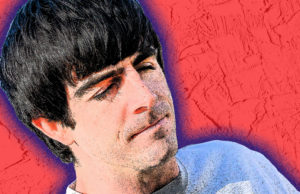— The happiest place on Earth has a doppelganger. It’s called
Wasteland. Its denizens are forgotten, dejected and resentful. But
they’re not seething with rage. This is after all still a
This is Epic Mickey, a video game whose dark undertones and tale of redemption
executives vehemently denied any attempt to remake the company’s
mascot, the game is garnering buzz precisely because it appears to
offer an edgier version of
“Part of the game’s appeal is the fact that it delves into the
is trying to take a family-friendly character, add a bit of suspense
and darken the palette with the hope that gamers will see Mickey in a
whole new light.”
In Epic Mickey, an early
Its story line picks up where “Fantasia” left off. In the 1940 movie,
Mickey stumbles into a magician’s lab where he picks up a wand and
conjures music by bringing life to the objects in the lab.
The game (suggested retail price:
can be played only on the Nintendo Wii. IGN called Epic Mickey “one of
the Wii’s most anticipated games of 2010.” Gamespot, another game
review site, ranked it among the 15 likely most popular titles of the
year.
practice of granting artistic license to A-list directors and other
top-flight creative types who want to work with its classic characters,
as was the case with director
annually in global sales of toys and other merchandise. He is a
mainstay at the company’s theme parks and on its cruise ships, and he
and his longtime pals
Game developer
Five years ago, Spector was recruited to develop the
game when the concept was hatched by a group of interns in the
company’s video game division.
Spector is a kind of developer’s developer. At 55,
he likes to joke that he is the nation’s oldest game creator. Behind
the graying beard, V-neck sweaters and wire-rimmed spectacles, however,
is a person obsessed with playing on the edge of interactive
entertainment. His games, including the Deus Ex trilogy and Thief:
Deadly Shadows, were known for intricate, sometimes mind-bending, plots
that let players explore multiple narrative paths. Deus Ex this year
topped PC Gamer magazine’s list of the top 100 computer games of all
time.
“
Mamet of gaming,” Steinberg said. “His games don’t speak down to
players. They’re known for being deep, erudite and sophisticated. For
Epic Mickey, Warren will be as much of an attraction as
It helps that Spector is a devoted
Asked whether teenage gamers would embrace Mickey, Spector, who teaches animation and film criticism at the
replied, “The better question is, ‘Why shouldn’t they?’ Gamers have no
problem playing hours with a blue hedgehog or a cartoon plumber. Why
would they have trouble with a mouse they grew up with? Mickey is a
character that we all have a relationship with.”
It’s no easy feat making an octogenarian — and contemporary of
When he made his cinematic debut in 1928 in
“Steamboat Willie” — the first animated cartoon synchronized with sound
— he was an impish deckhand on a riverboat who delights Minnie by
squeezing, pummeling and tweaking the barnyard menagerie on board to
play “
behaved in ways that today’s audiences would find surprising, including
the 1928 Douglas Fairbanks parody “The Gallopin’ Goucho,” in which
Mickey smokes, guzzles beer and ogles Minnie as she performs a
seductive Latin dance. “Initially, he’s mischievous,” said
By the late 1930s, Mickey’s personality softened. The late paleontologist
progressively more juvenile in appearance as his behavior became
“blander and inoffensive.”
Art historian
said the character reached his apogee when he appeared as the
Sorcerer’s Apprentice in “Fantasia” and was virtually conscripted by
the Allies as part of the World War II effort. Indeed, the character’s
name was used as the password for one of the most important briefings
of the 1944 D-day invasion of Normandy.
The ubiquitous creature has appeared as the host of
the popular children’s television series “The Mickey Mouse Club,” which
debuted in
Mickey’s career in video games started in 1981 on a portable console from
called the Game & Watch. In his first game, called simply Mickey
Mouse, players maneuvered him to catch eggs laid by four hens before
they splattered.
Since then, he’s appeared in more than two dozen
titles. His scorecard, however, has been mixed. Two titles, Castle of
Illusion in 1990 and Kingdom Hearts in 2002, were critical hits, along
with their sequels, according to a survey by
After those scathing reviews, the company hit the pause button on Mickey games.
video game unit, was intrigued when his interns presented their idea
for a darker, more suspenseful game. Gone were the bright colors and
the blithe but bland themes. Its characters, even the friendly ones,
held grudges and had sarcastic streaks. And the monsters meant
business. In one scene in the game, Mickey is strapped to an operating
table as a machine attempts to extract his heart with a plunger. In
this title, Mickey could let loose and kick some butt.
The plot also called for a return of Oswald the Lucky Rabbit, a character
“We started with that canonical moment when Mickey
puts on the hat and picks up the wand,” Spector said. “That’s where all
of Mickey’s essential characteristics come together. He leaps before he
looks. He gets himself into trouble, and he has to figure a way to get
himself out. He has this childlike sense of mischief and wonder.”
As Mickey conducts, he accidentally spills magic ink
that coagulates into an evil force in Wasteland called the Phantom
Blot. In the game, Mickey must somehow correct his blunder and make
peace with Oswald, who deeply resents Mickey’s successes.
But how Mickey redeems himself is up to the player.
Spector designed the game to give players multiple options, each
involving a series of cascading consequences. “The game is tracking
what you do behind the scenes,” Spector said. “So if you’re clever, you
can create situations that even we as developers don’t know about.” In
one scene that takes place in an area called Ventureland, players are
confronted with a machine that turns pirates into animatronic monsters.
Players can do nothing, destroy the machine or fix it so it creates
cartoon characters.
cows, applauded Spector for finding a way to reintroduce some
vulnerabilities to Mickey. “This seems to be a great opportunity to
recapture conflict and energy around the story,” Hardison said.
Industry analyst
does a solid job marketing Epic Mickey. But the game already has one
important drawback — its graphics on the Wii look crude when stacked up
against games developed for the more powerful Xbox 360 or PlayStation 3
consoles, Keighley said.
“It’s a shame, because the art and world for Epic
Mickey is so dynamic and rich,” Keighley said. “Can older kids see
beyond that and view it as a legitimate game? The jury is still out on
that.”
———
(c) 2010, Los Angeles Times.
Visit the Los Angeles Times on the Internet at http://www.latimes.com/.
Distributed by McClatchy-Tribune Information Services.














